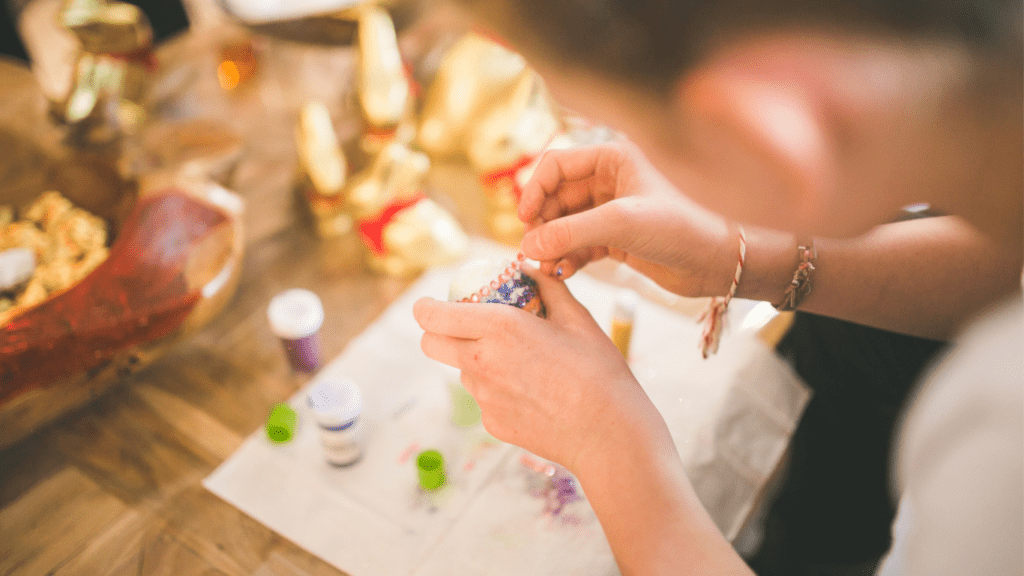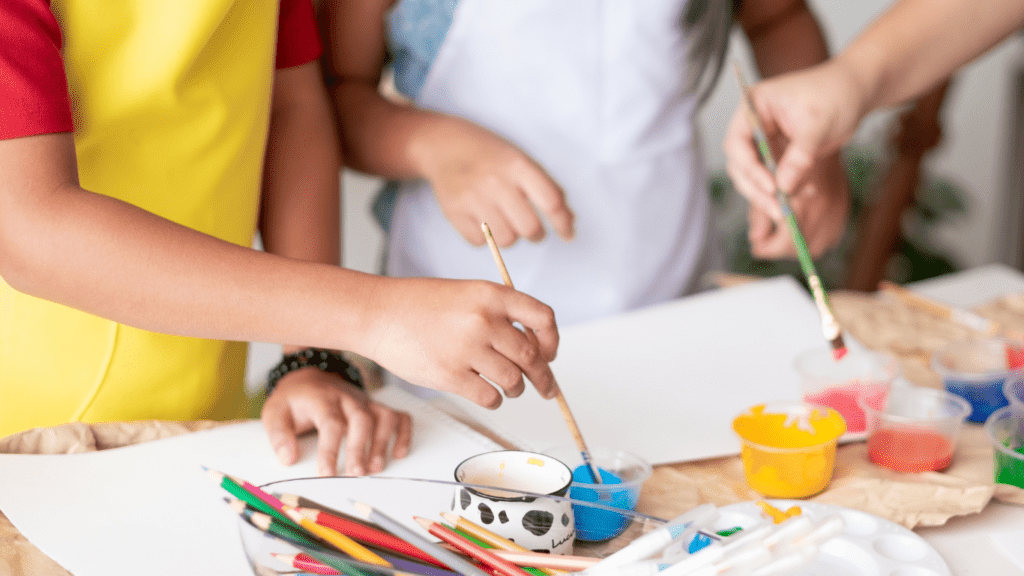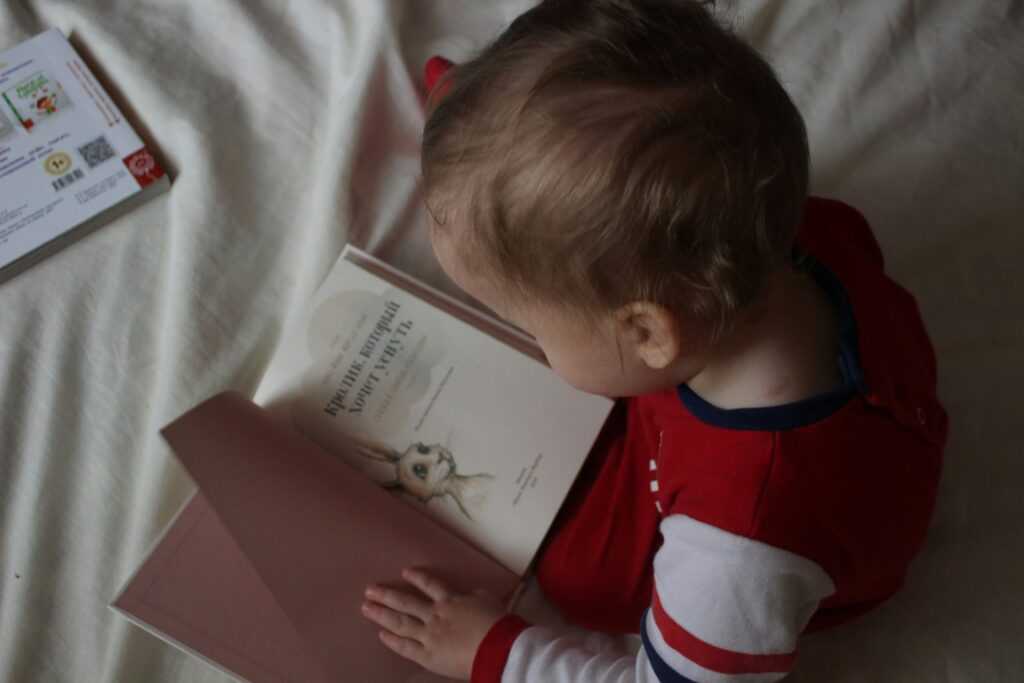The Role of Arts and Crafts in Enhancing Creativity
Arts and crafts activities serve as a foundation for enhancing creativity in children. These activities encourage imaginative thinking and problem-solving skills.
Boosting Imaginative Thinking
Children’s engagement in arts and crafts activities boosts their imaginative thinking. By providing various materials like colored paper, glue, and markers, children explore new ideas and create unique projects.
This creative exploration helps them see possibilities beyond the conventional, promoting original thought. When children draw fantastical creatures or paint abstract forms, they engage their imagination, enabling them to think more freely and creatively.
Fostering Problem-Solving Skills
Arts and crafts also foster problem-solving skills in children. When faced with challenges like a broken crayon or needing to mix colors to get the right shade, children learn to think critically and find solutions.
This process improves their ability to approach problems from different angles. Building models or crafting intricate designs requires planning and perseverance, enhancing their problem-solving aptitude and resilience.
Cognitive Benefits of Arts and Crafts
Arts and crafts play a vital role in enhancing children’s cognitive development. These activities stimulate various brain functions, resulting in critical thinking and improved learning capabilities.
Improving Concentration and Focus
Arts and crafts activities require children to pay close attention to detail and follow step-by-step instructions. This process improves concentration and focus, crucial skills for academic success.
When children immerse themselves in tasks like coloring intricate patterns or assembling models, they learn to block out distractions and maintain sustained attention.
Development of Fine Motor Skills
Handling arts and crafts materials develops fine motor skills. Children manipulate tools, such as:
- scissors
- brushes
- glue
Enhancing hand-eye coordination and dexterity.
For example, cutting along lines or molding clay figures forces precise movements. This practice strengthens small muscles in the hands and fingers, beneficial for writing and other daily tasks.
Emotional and Social Advantages
Engaging in arts and crafts greatly benefits children’s emotional and social development. These activities create opportunities for kids to express themselves and interact with others in meaningful ways.
Expressing Emotions Through Art
Children find a healthy outlet for their emotions through art. Drawing or painting allows them to visualize feelings they might struggle to articulate verbally.
For instance, a child might use colors to represent happiness or sadness. This form of expression aids emotional literacy which is crucial in developing empathy and self-awareness. Psychologist Cathy Malchiodi notes that visual art can foster emotional release and insight.
Collaborating and Sharing in Group Projects
Group arts and crafts activities teach essential social skills. Children learn collaboration, sharing materials, and respecting others’ contributions during group projects.
For example, while building a group mural, kids jointly decide on themes and divide tasks. This teamwork improves communication skills and cultivates a sense of community.
According to educational studies, these collaborative efforts positively impact interpersonal relationships and social harmony among children.
Integrating Arts and Crafts into Daily Learning

Arts and crafts activities play a crucial role in child development, blending seamlessly into daily learning routines. By incorporating creative tasks regularly, children benefit from continuous developmental growth.
Practical Tips for Parents and Educators
Implementing arts and crafts into everyday learning is straightforward:
- Dedicated Space: Designate a specific area for creative activities. Ensure it’s stocked with materials like paper, crayons, glue, and scissors.
- Scheduled Time: Allocate daily or weekly time slots for arts and crafts to establish a routine.
- Thematic Projects: Align projects with current learning themes. For example, create animal masks during a biology unit.
- Open-Ended Tasks: Offer activities without strict guidelines to promote creativity. Let children draw anything they imagine, using various tools.
- Incorporate Technology: Use digital tools for drawing or design projects, blending traditional and modern methods.
Encouraging Artistic Expression at Home
Encouraging creativity at home enhances its developmental benefits:
- Family Projects: Engage in collaborative family art projects to bond while creating. Make a family tree using different materials, enhancing artistic skills and family connectivity.
- Art Displays: Showcase children’s artwork at home to boost their self-esteem. Rotate displayed pieces to keep the environment fresh and engaging.
- Read and Create: Pair reading with associated art projects. After reading a story, ask children to draw scenes or characters.
- Resource Accessibility: Keep art supplies accessible to encourage spontaneous creativity. Set up a small, accessible art station with essentials like markers, paper, and clay.
- Positive Feedback: Give positive reinforcement for creative efforts, focusing on the process rather than the result.
Integrating arts and crafts into daily learning routines transforms mundane activities into opportunities for growth, fostering comprehensive child development.

 Hazeliin Davidsoninn, the founder of Toddler Health Roll, is an insightful article writer with a passion for children's health and well-being. Her writing reflects a deep understanding of the challenges parents face when raising toddlers, offering practical advice grounded in the latest pediatric research. With a keen eye for detail and a compassionate approach, Hazeliin's articles provide parents with the tools they need to nurture their children's physical, mental, and emotional health.
Beyond her expertise in child health, Hazeliin's writing also delves into the complexities of toddler nutrition, travel with young children, and effective parenting strategies. Her dedication to sharing valuable knowledge with her readers has made Toddler Health Roll a trusted resource for parents seeking guidance on raising happy, healthy toddlers.
Hazeliin Davidsoninn, the founder of Toddler Health Roll, is an insightful article writer with a passion for children's health and well-being. Her writing reflects a deep understanding of the challenges parents face when raising toddlers, offering practical advice grounded in the latest pediatric research. With a keen eye for detail and a compassionate approach, Hazeliin's articles provide parents with the tools they need to nurture their children's physical, mental, and emotional health.
Beyond her expertise in child health, Hazeliin's writing also delves into the complexities of toddler nutrition, travel with young children, and effective parenting strategies. Her dedication to sharing valuable knowledge with her readers has made Toddler Health Roll a trusted resource for parents seeking guidance on raising happy, healthy toddlers.
